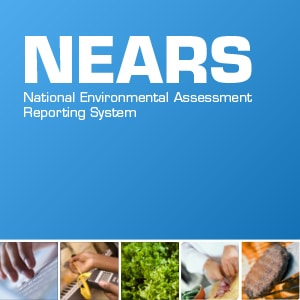NEARS FAQs

What are the benefits of NEARS participation for state and local food safety programs?
NEARS provides important benefits to participants; examples include
- Practical information on conducting environmental assessments as part of foodborne illness outbreaks, such as
- A NEARS data reporting instrument and
- Environmental assessment training.
- A free data entry and storage system to document and track environmental assessment data from foodborne illness outbreak responses (for information on how NEARS relates to CDC’s National Outbreak Reporting System, NORS, see below).
- Access to other participating state and local food safety programs, fostering collaboration and communication.
- NEARS annual summary reports for data submitted by your state or local food safety program.
- Visit NEARS Resources for a comprehensive report of outbreaks reported to NEARS from all participating state and local food safety programs (view our NEARS Participants page for a list and map of current participants).
NEARS also helps the national food safety system by providing critical data from these environmental assessments to prevent and reduce future outbreaks.
Can participating in NEARS help my food safety program meet the Food and Drug Administration’s Retail Food Program Standards?
Yes. Participating in NEARS can help food safety programs meet the requirements for Standard 5 [PDF – 114 KB] (Foodborne Illness and Food Defense Preparedness and Response) of FDA’s Retail Food Program Standards. This standard recommends NEARS as a framework programs that regulate restaurants and other retail food establishments can use to actively address risk factors more commonly associated with foodborne illness.
How are NEARS data stored?
Data are held on a central server complying with all security policies for CDC and the U.S. Department of Health and Human Services.
What does it cost to participate in NEARS?
Participating in NEARS is free, and so is registering for CDC’s recommended training for NEARS participants.
Conducting thorough and complete environmental assessments during outbreak investigations takes time and resources. But the data gained during these environmental assessments are critical to understanding how and why the outbreak occurred. And these data can be used to prevent future outbreaks.
What training is recommended for conducting environmental assessments and reporting environmental assessment data to NEARS?
CDC highly recommends all NEARS users take its free Environmental Assessment Training Series (EATS). Successful course completion will improve data quality in NEARS and improve trainees’ skills in conducting environmental assessments.
If my state food safety program is not participating in NEARS, can my local food safety program still participate in NEARS?
Yes. CDC encourages state participation, but local food safety programs can register and begin reporting outbreak data to NEARS even if their state does not participate.
How soon can food safety programs access their data once reported to NEARS?
Food safety programs can immediately access and download their data for further analysis.
Each state or local food safety program identifies NEARS administrators. These administrators can access and download all data entered into NEARS by their respective state or local food safety program.
What is the difference between the CDC’s NORS and NEARS?
NORS is an outbreak surveillance system typically used by state epidemiologists to report epidemiology and laboratory components of outbreak data, such as
- Date and location of the outbreak,
- Number of people who became ill and their symptoms, and
- Pathogen that caused the outbreak.
NEARS is a companion surveillance system to NORS. NEARS is typically used by state and local environmental health specialists to report foodborne illness outbreak data not collected by NORS. NEARS collects outbreak data on restaurants and other retail food service establishments related to
- Environmental factors of an outbreak (contributing factors, for example, food preparation practices that lead to food getting contaminated with germs), and
- Why these factors occurred (environmental antecedents or root causes).
NEARS data help food safety programs understand how and why outbreaks occur so that they can be prevented.
Reporting data to both NEARS and NORS for the same outbreak provides a more complete picture of the epidemiology, laboratory, and environmental health components of foodborne illness outbreaks. While there is minimal overlap, NEARS and NORS are exploring stronger integration to make it more seamless. As with any outbreak investigation, CDC encourages epidemiologists and environmental health staff to share findings with each other.
Can food safety programs report data for an outbreak to NEARS even if data on that outbreak is not reported to NORS?
Yes. Food safety programs do not have to report data to NORS in order to report it to NEARS.
Outbreak data reported to both NORS and NEARS can be linked. CDC encourages food safety programs to report foodborne illness outbreak data to both NEARS and NORS for a more complete picture of the epidemiology, laboratory, and environmental health components of these outbreaks.
Get help with NEARS
Contact us for NEARS questions and technical assistance.